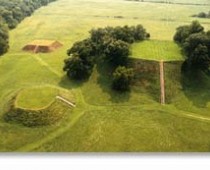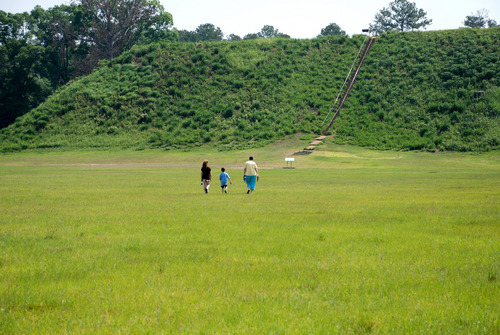Ancient Native American Sites in Georgia | Part 1: Overview & Introduction
 The state of Georgia is home to some of the most important remains of Native American culture in North America. Native Americans constructed impressive structures, referred to as Indian Mounds, throughout the state for over 4,000 years. On the Atlantic coast they constructed the Sapelo Shell Ring complex before the ancient Egyptians had started construction on their famous pyramids.
The state of Georgia is home to some of the most important remains of Native American culture in North America. Native Americans constructed impressive structures, referred to as Indian Mounds, throughout the state for over 4,000 years. On the Atlantic coast they constructed the Sapelo Shell Ring complex before the ancient Egyptians had started construction on their famous pyramids.
In the southwest of the state, possible Maya immigrants built one of the largest cities in North American starting in 350 AD known today as Kolomoki Mounds. In the central part of the state a 97 feet tall earthen pyramid was constructed at Ocmulgee Mounds in Macon, Georgia around 900 AD.
Around 1200 AD Georgia’s Indians constructed in the northern part of the state one of the most impressive towns in all of North America: Etowah Mounds. Amazing artifacts were uncovered that would rewrite the history of these native peoples.
So come along with us as we explore Georgia’s ancient Indian cities.
- Sapelo Shell Rings is the oldest of Georgia’s Native American villages. It was constructed around 2270 BC which makes the site older than Egypt’s pyramids. Located on Sapelo Island on the southeastern Atlantic coast of the state, the site consists of three large rings constructed from tons of seashells. The largest of the three rings is over 20 feet high with a circumference of 255 feet.
- Kolomoki Mounds in Blakely, Georgia consists of 7 Indian mounds built between the years 350-750 AD. It is believed that several thousand people lived here making it the largest Native American village during its time period. The largest of the mounds rises over 57 feet high and has a base larger than a football field. Two funeral mounds exist which were filled with exquisite pottery from the Swift Creek and Weeden Island traditions. The pottery is now housed in an on-site museum filled with many educational exhibits. Part of the museum is actually built over an excavated burial mound
- Ocmulgee Mounds in Macon, Georgia were constructed around 900 AD. The site consists of two large temple mounds that tower over the site and the river below. A funeral mound at the site was partially excavated and the amazing pottery and artifacts are now housed in an on-site museum. The pottery revealed that an outside group immigrated into the area and built the mounds (or at least took them over.) The most spectacular structure at Ocmulgee is the Earth Lodge, an earth covered structure with a circle of 50 seats inside.
- Etowah Mounds located in Cartersville, Georgia consists of three large earthen pyramids. The site is over 50 acres and is surrounded by a moat. It was also once surrounded by a log palisade wall as well. The funeral mound was excavated and a pair of marble statues were unearthed representing a man and woman, obviously an important couple at Etowah. The statues and other artifacts are now housed in the on-site museum.
For more info: Visit the Ancient Civilizations of Georgia exhibit at LostWorlds.org for more in-depth information about all of Georgia’s ancient Indian cities and monuments. Purchase the Lost Worlds: Georgia DVD to watch a documentary about these ancient lost civilizations.



